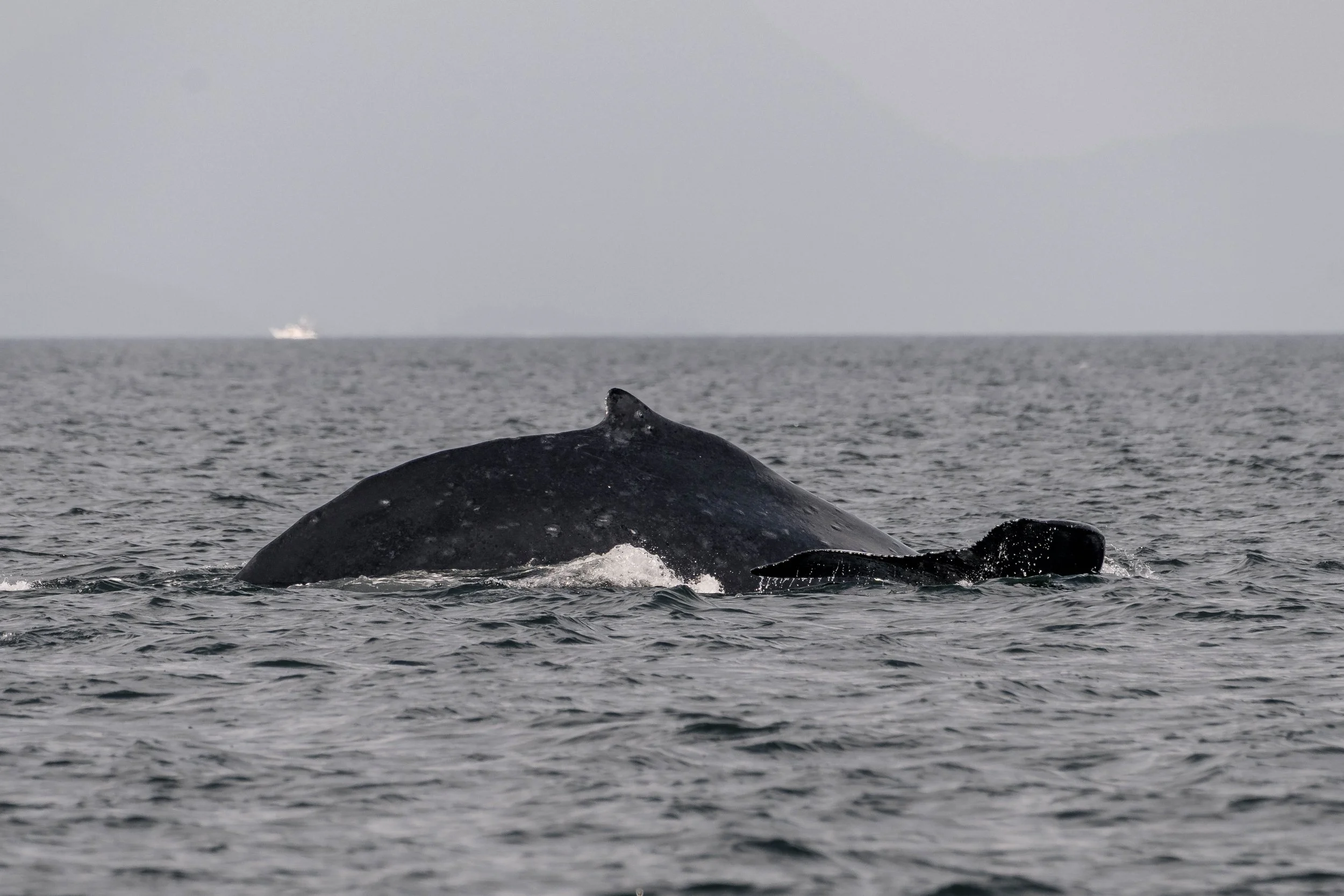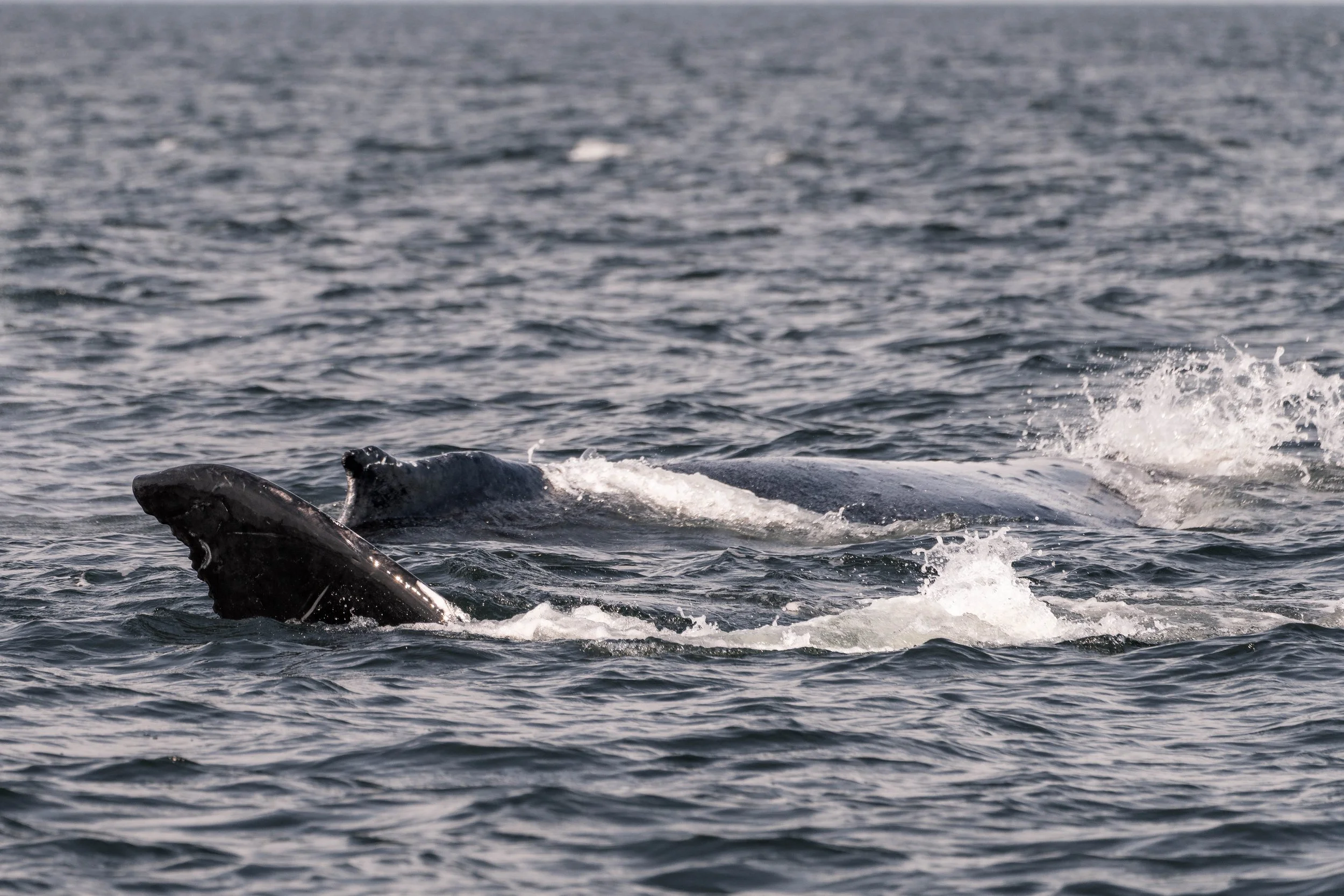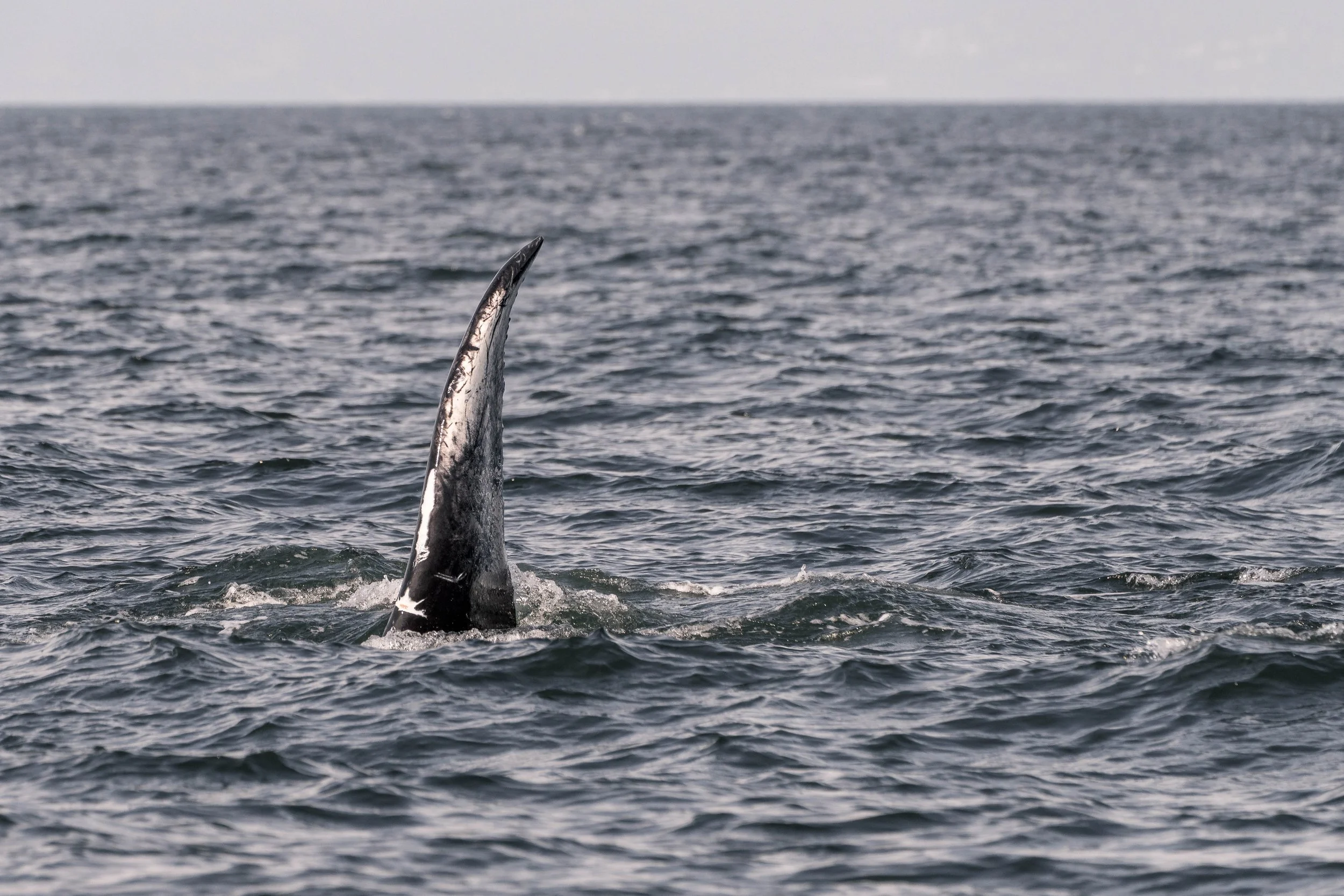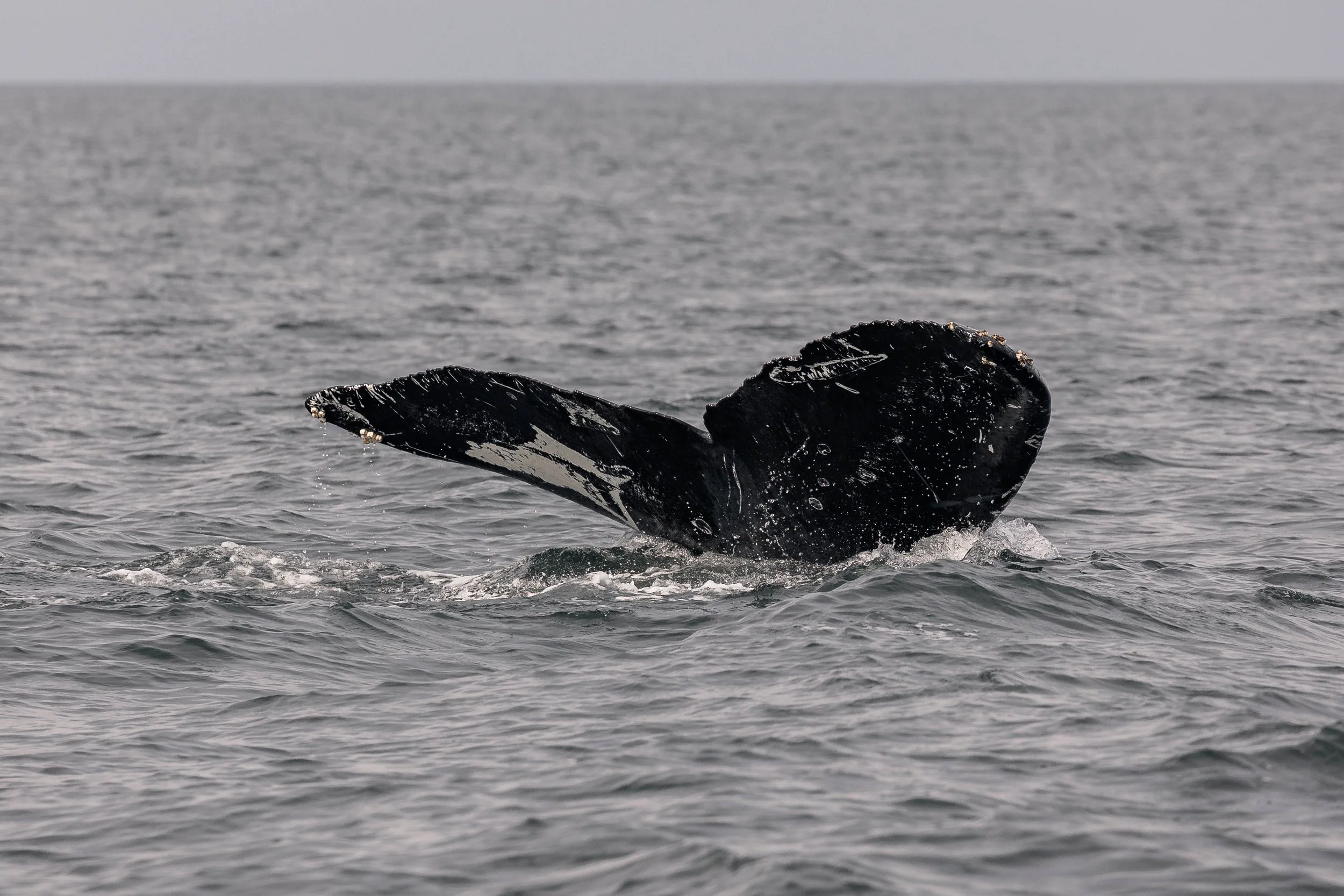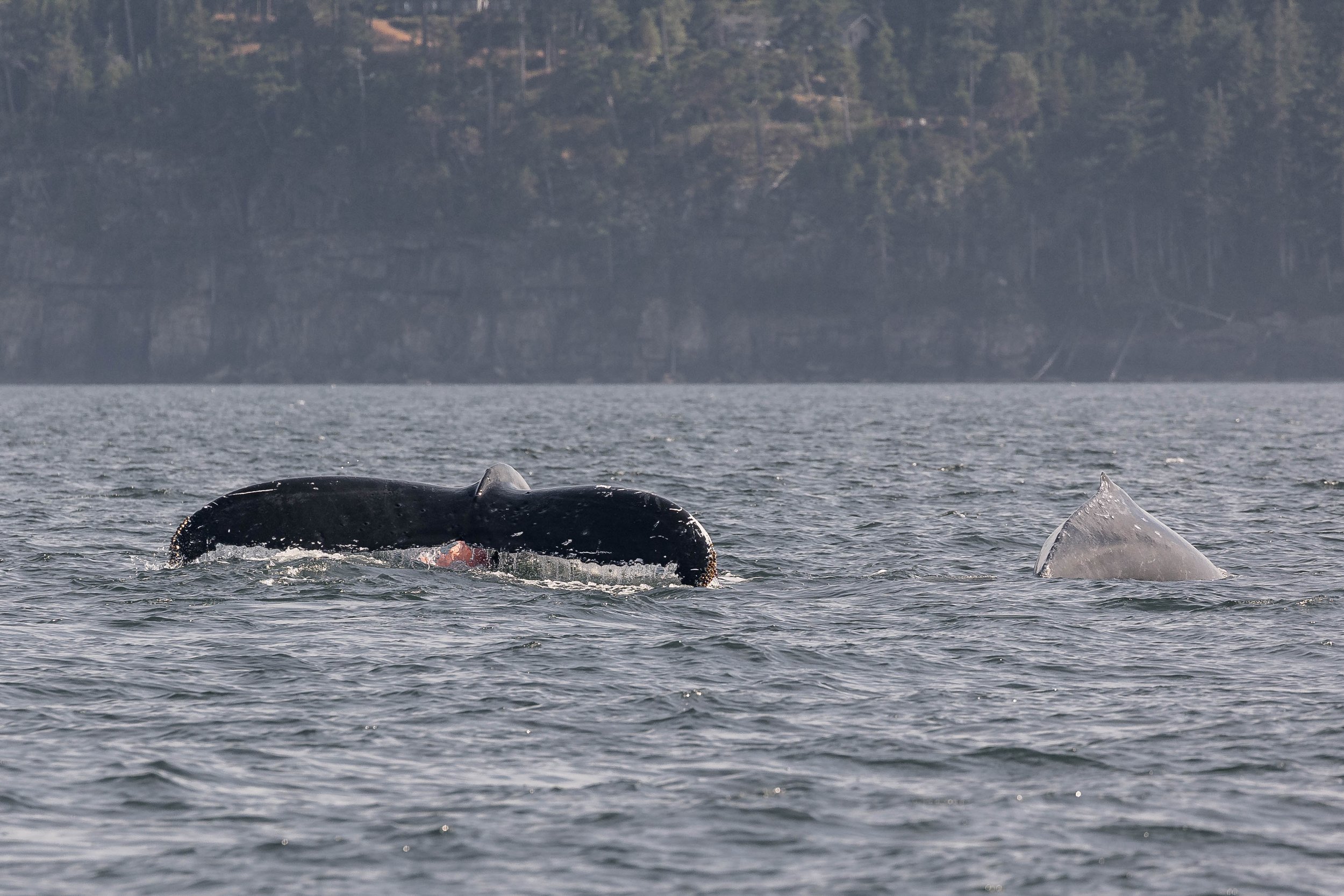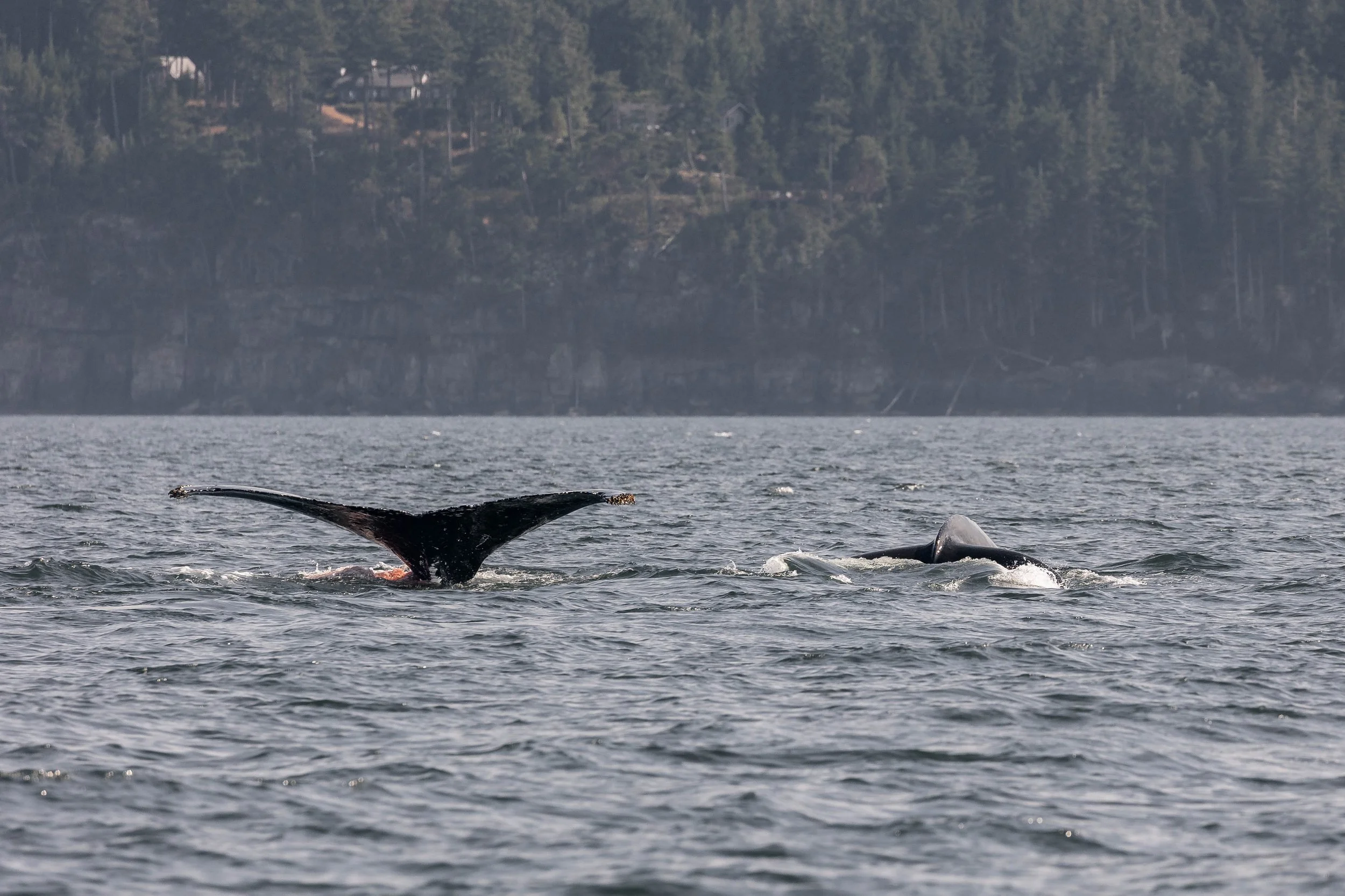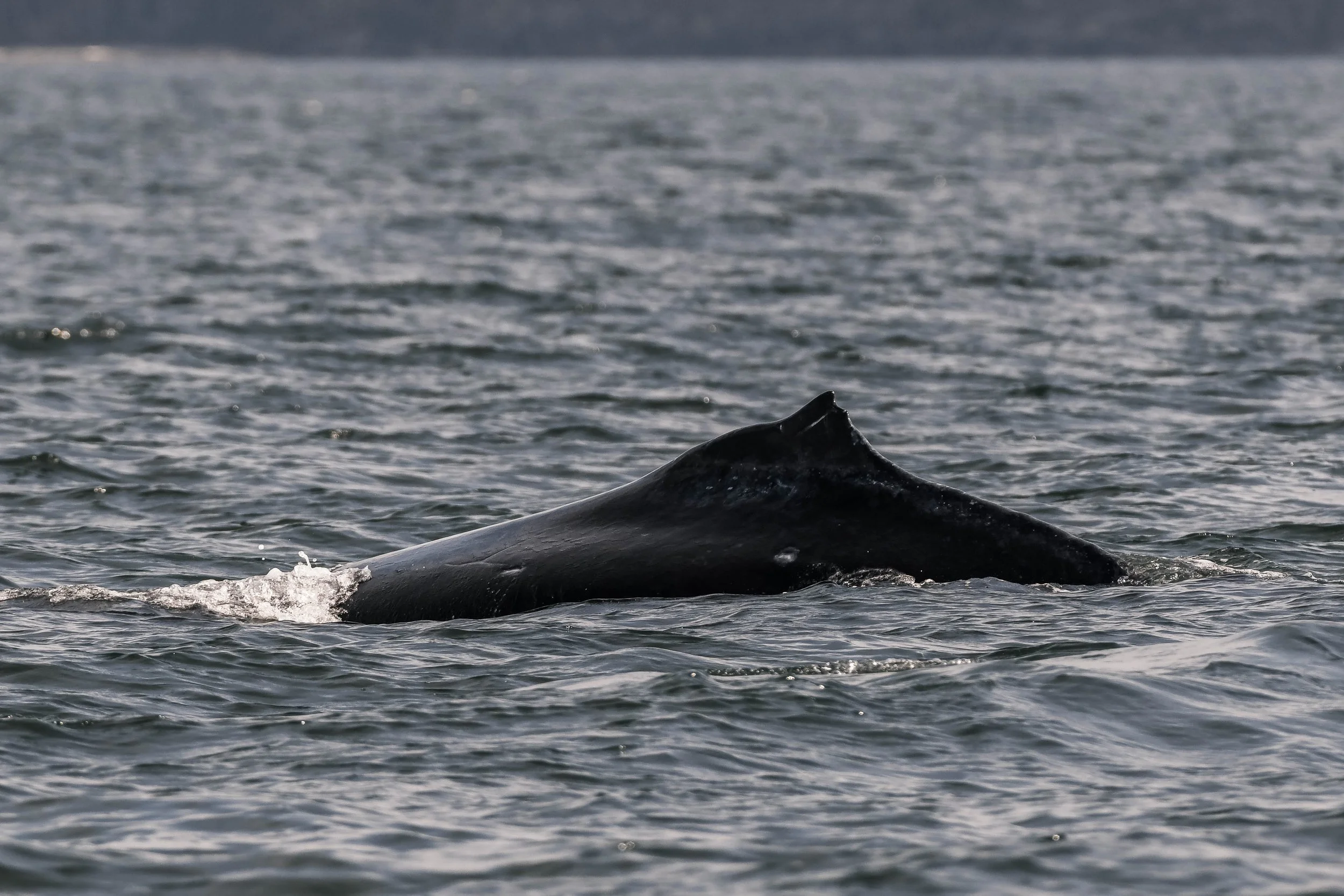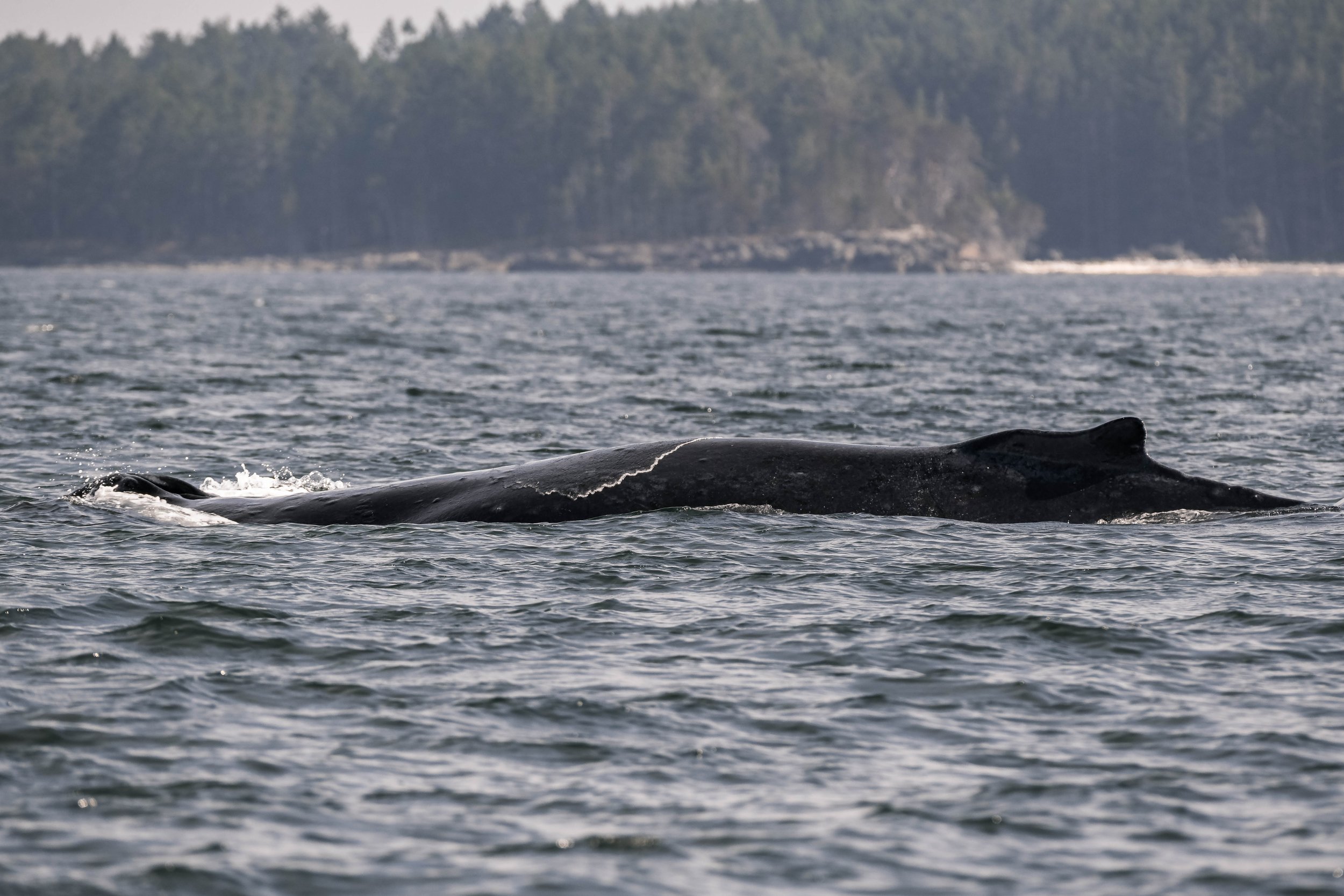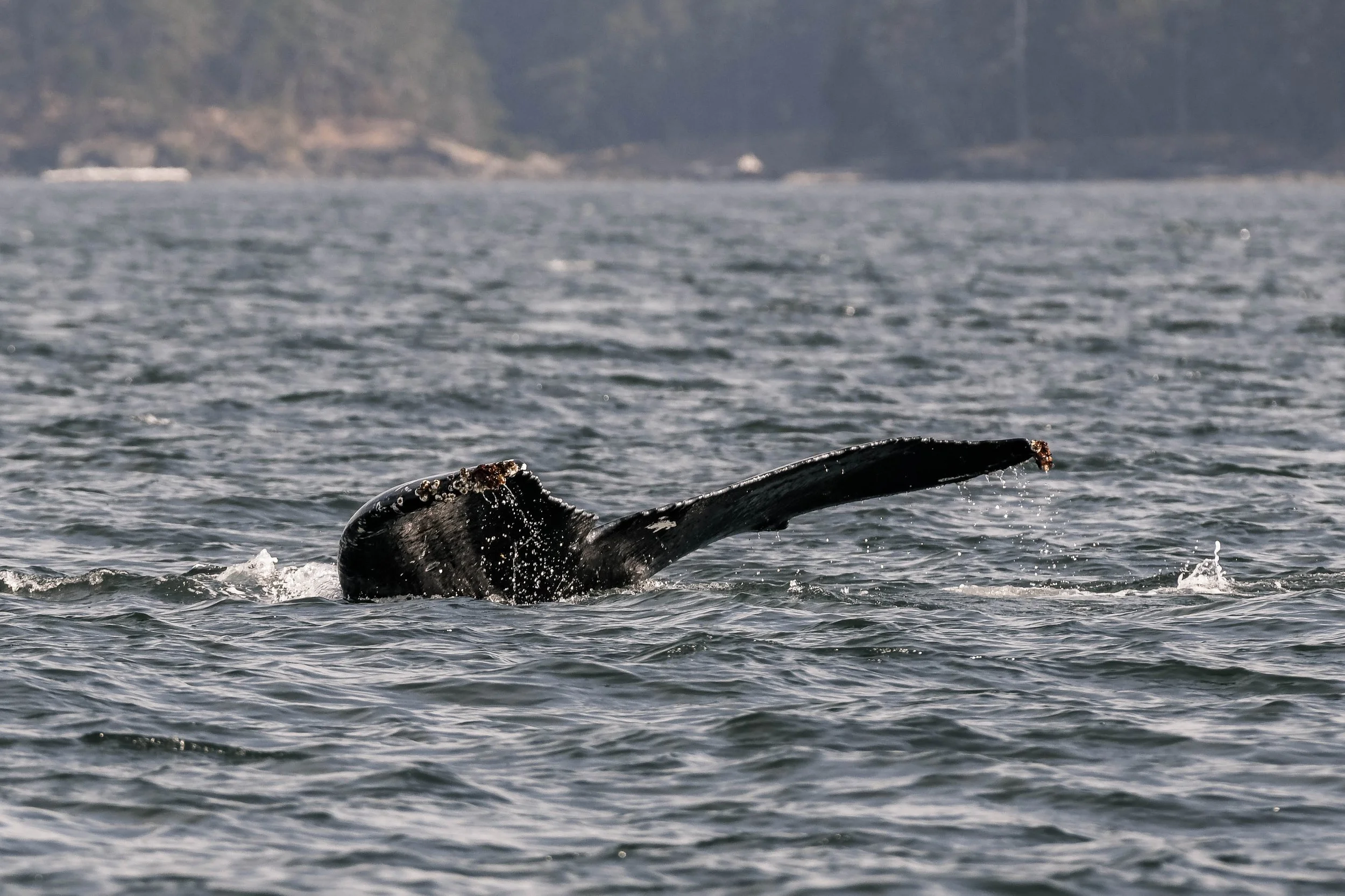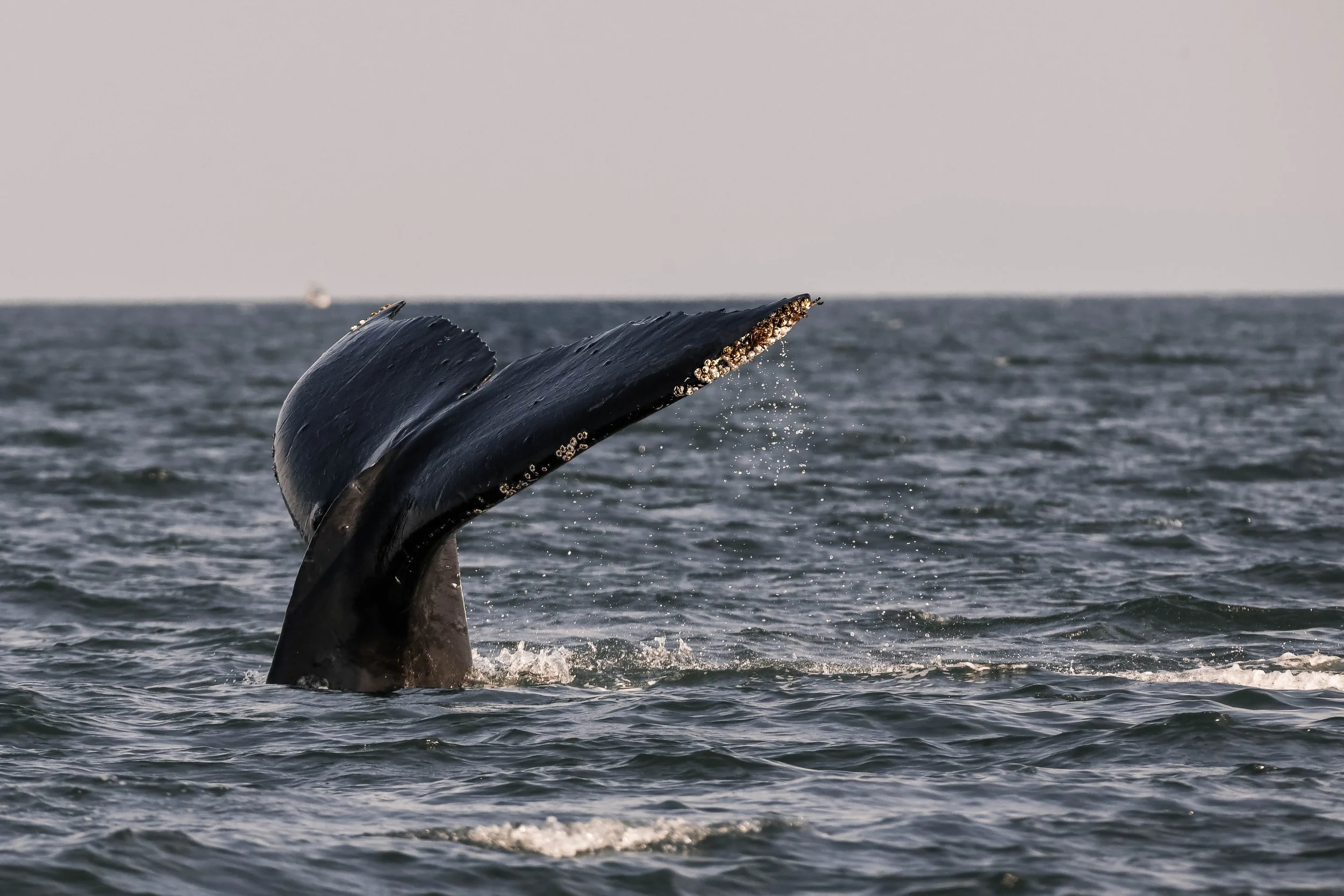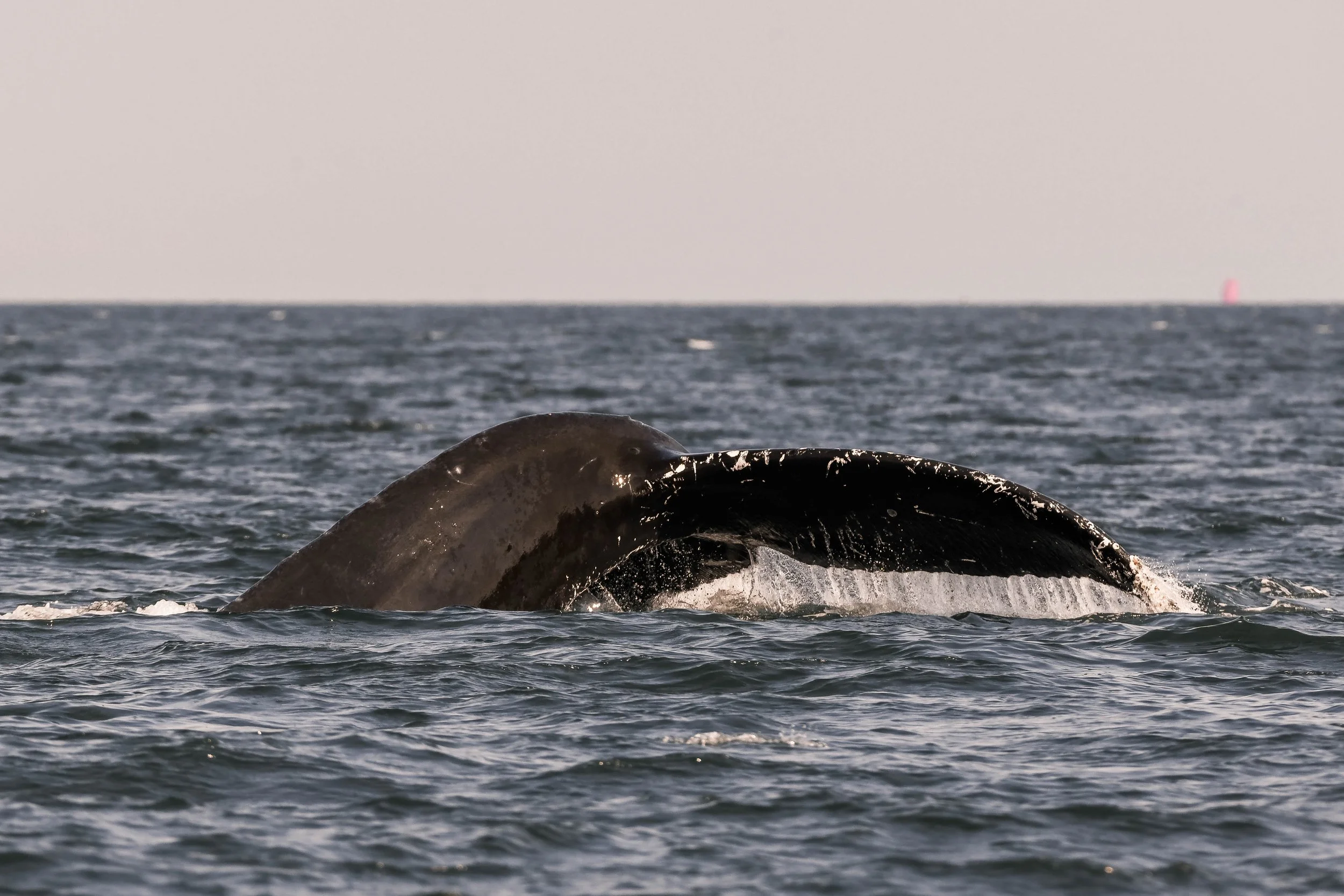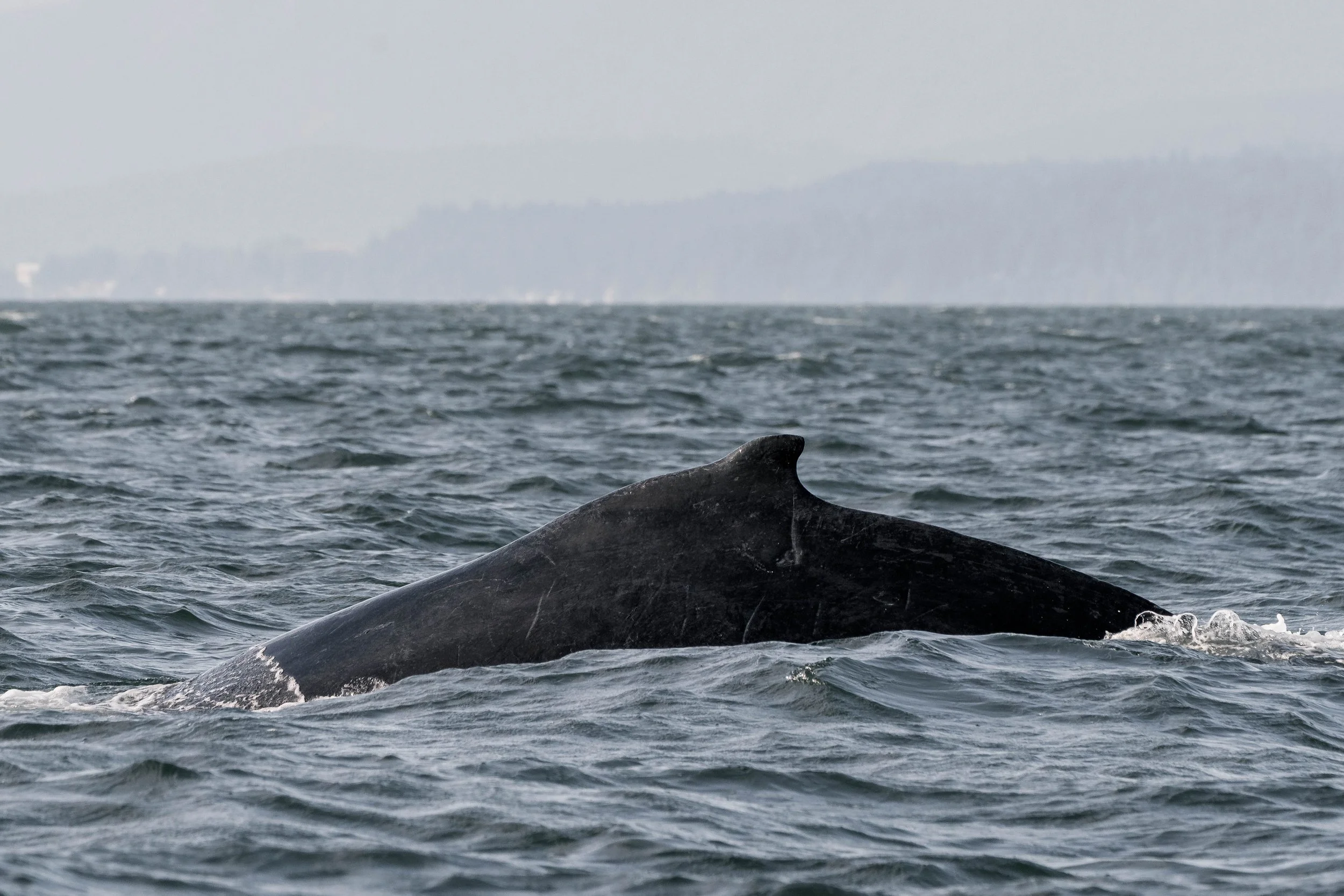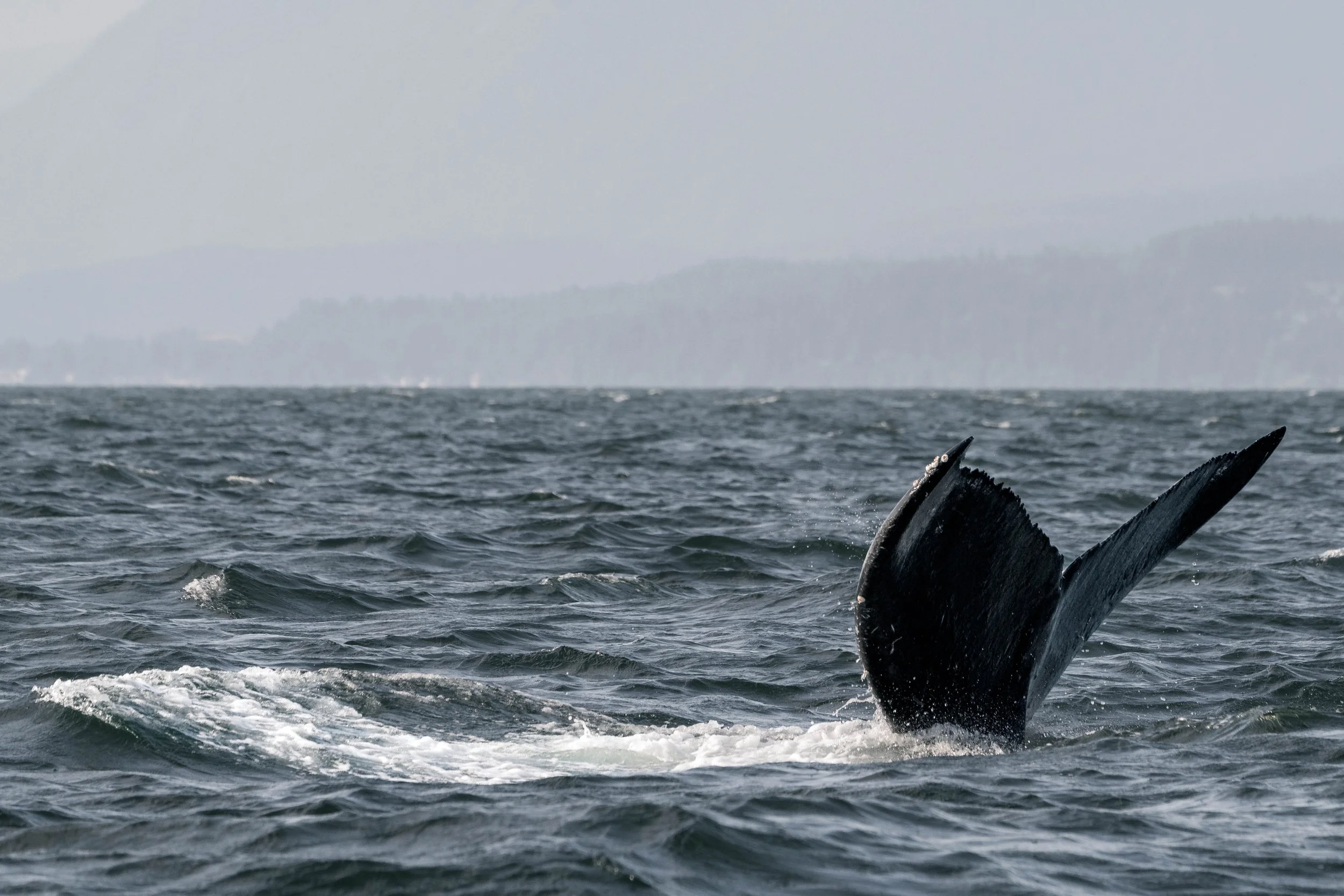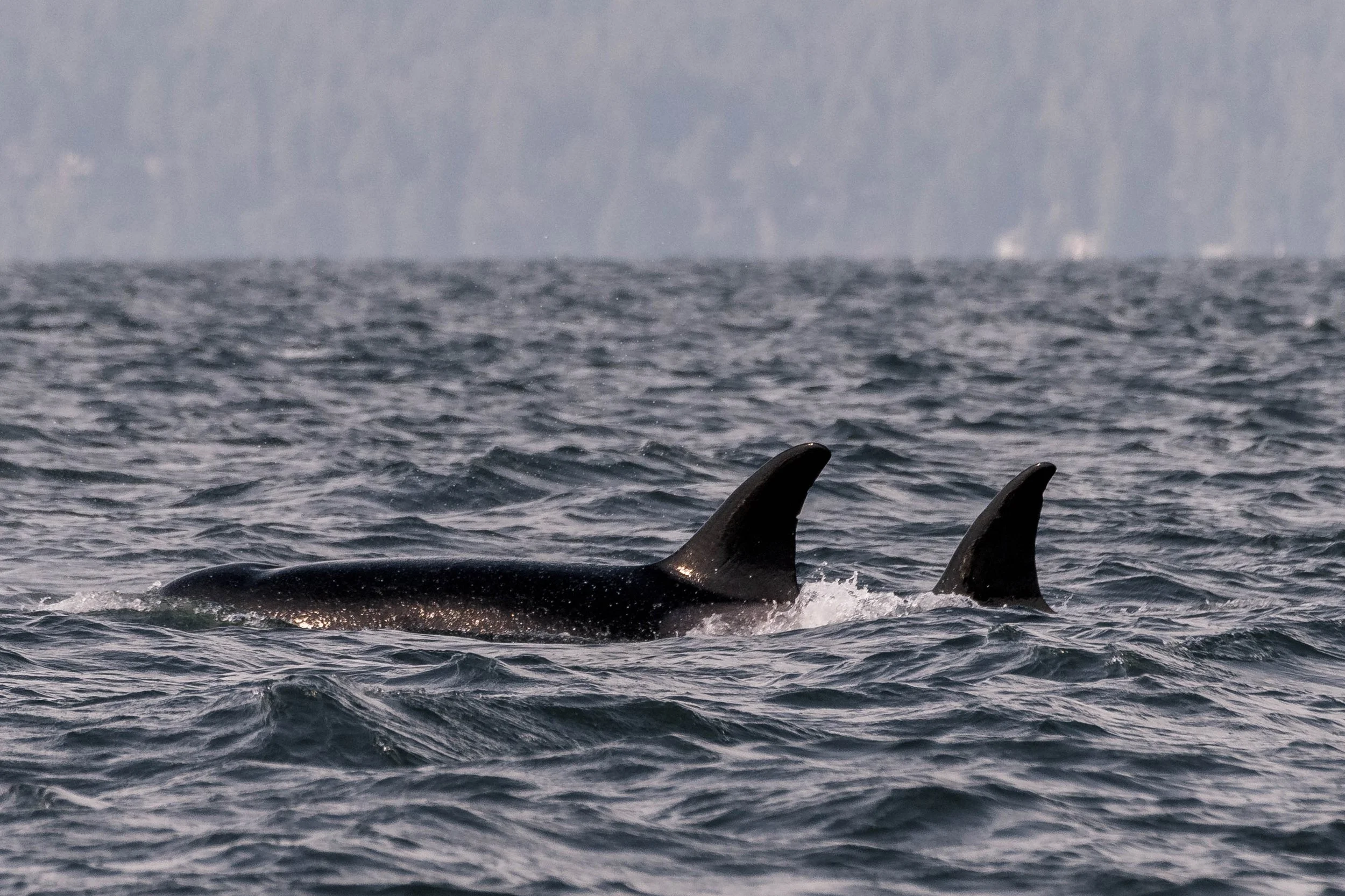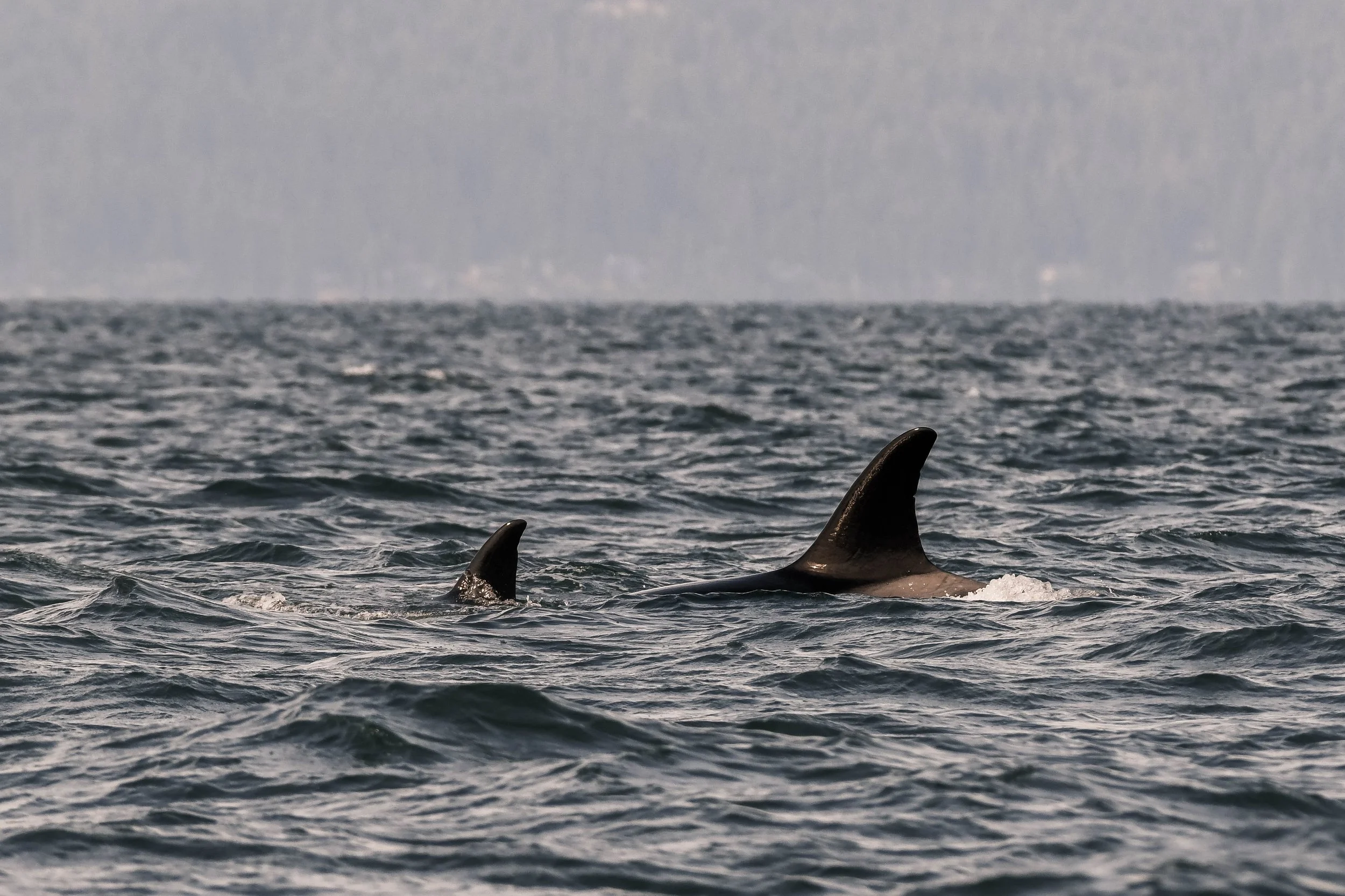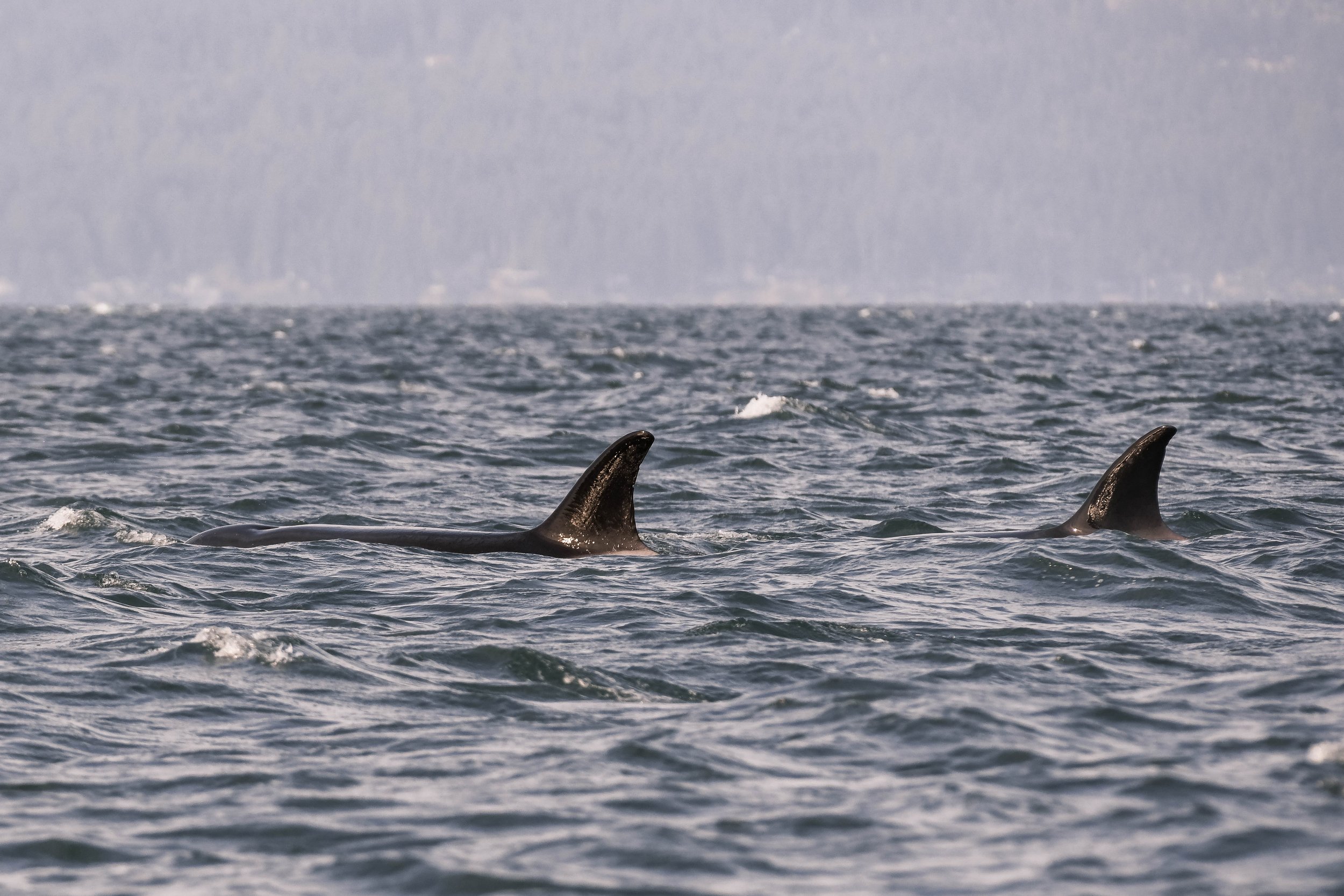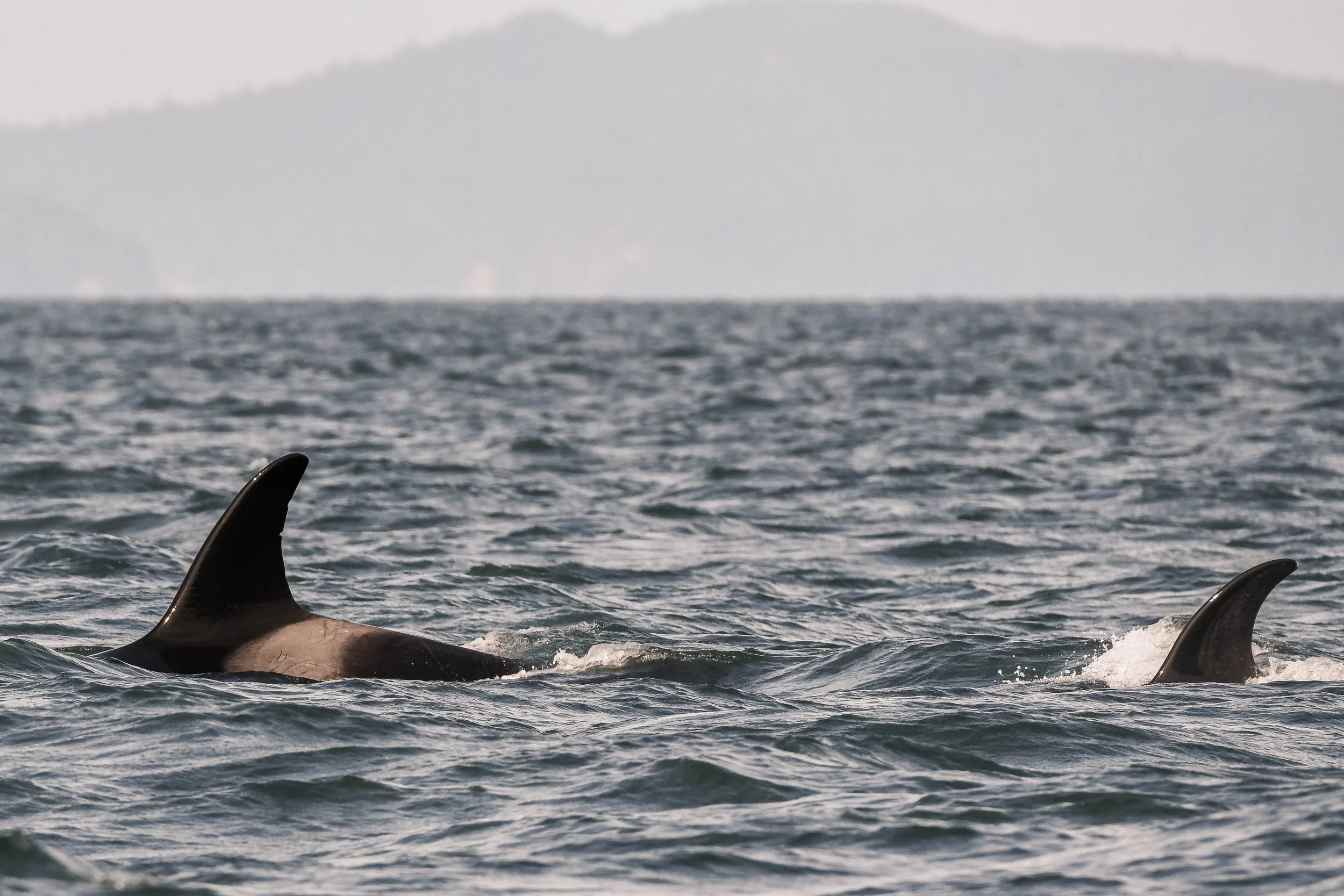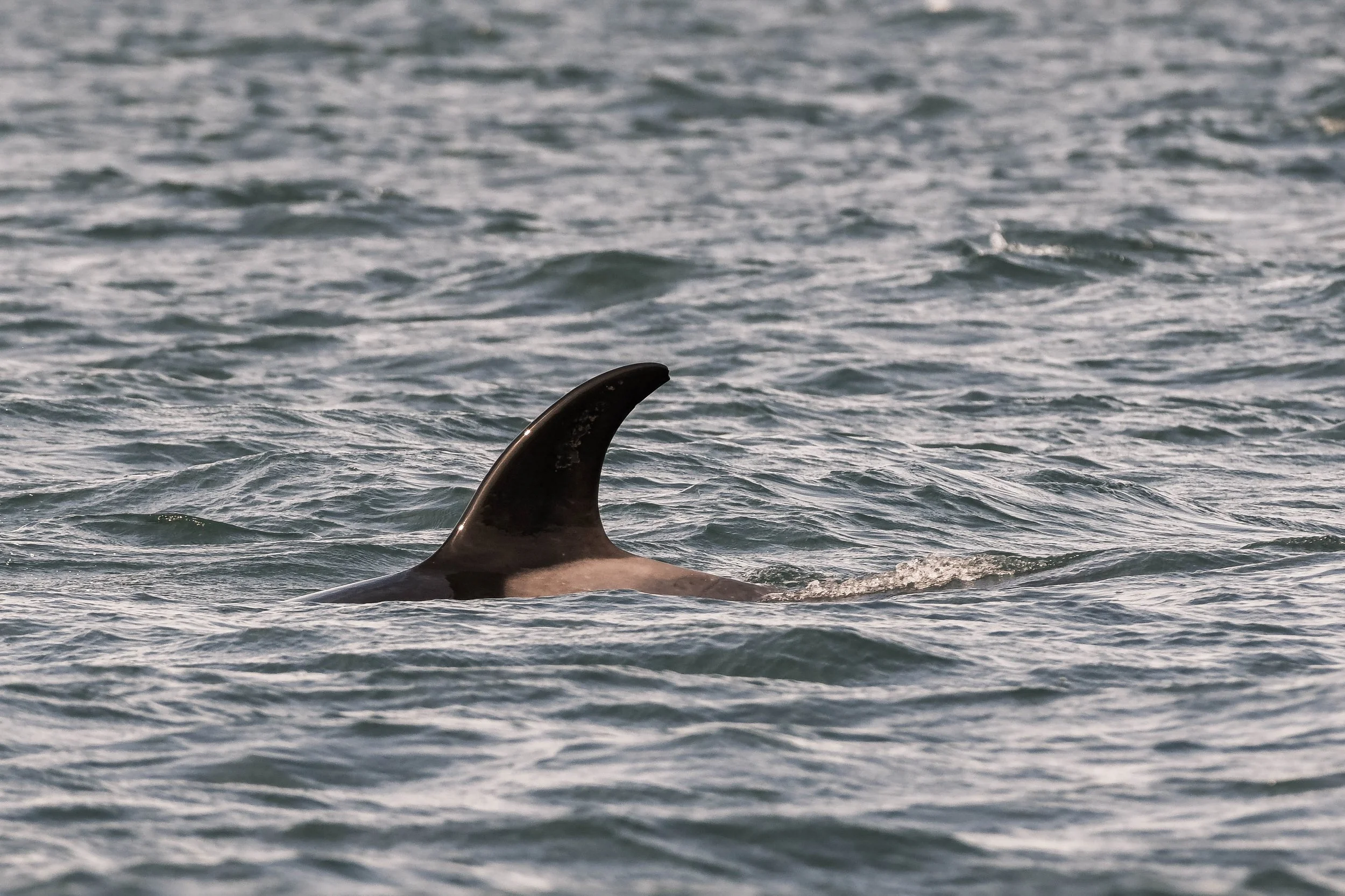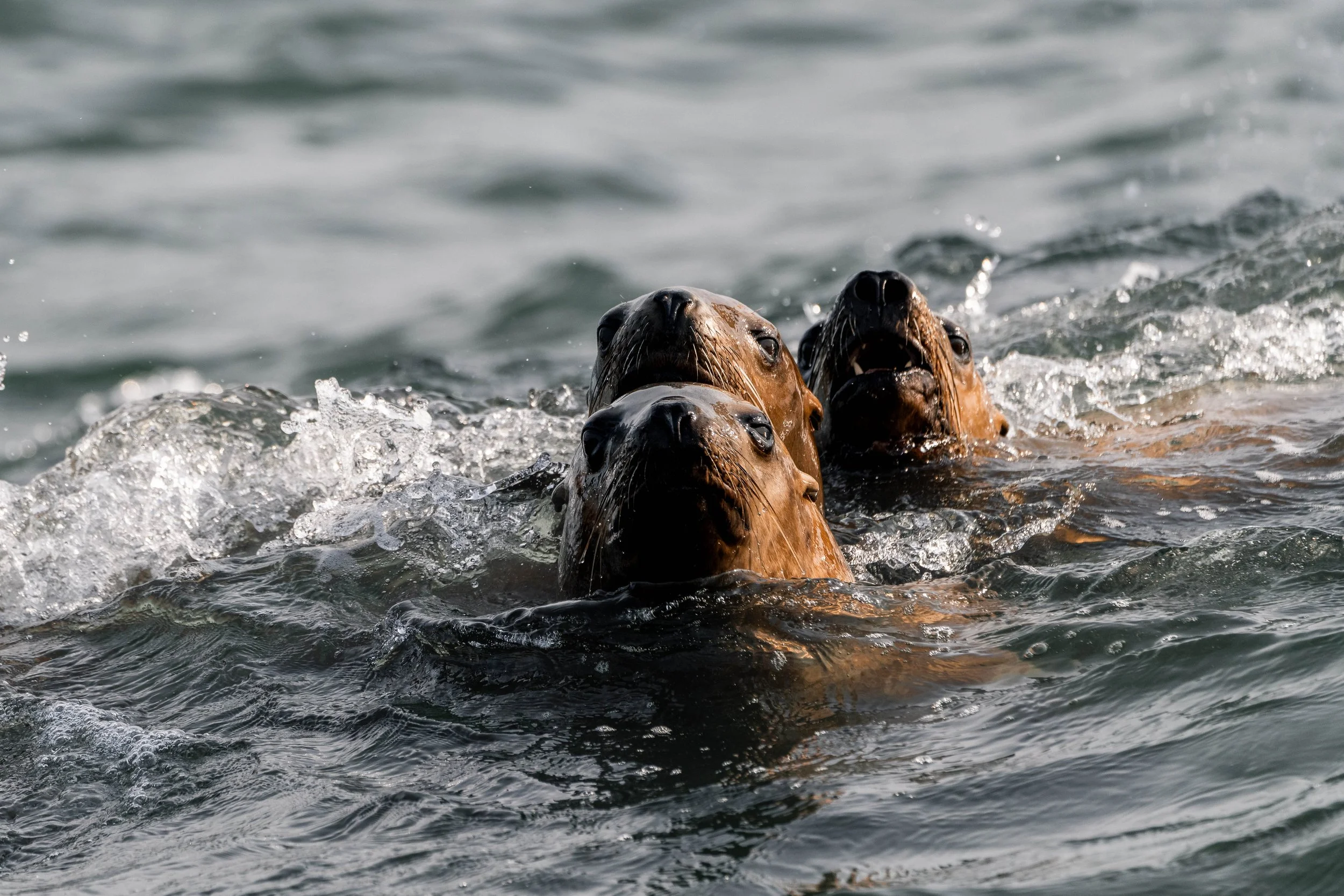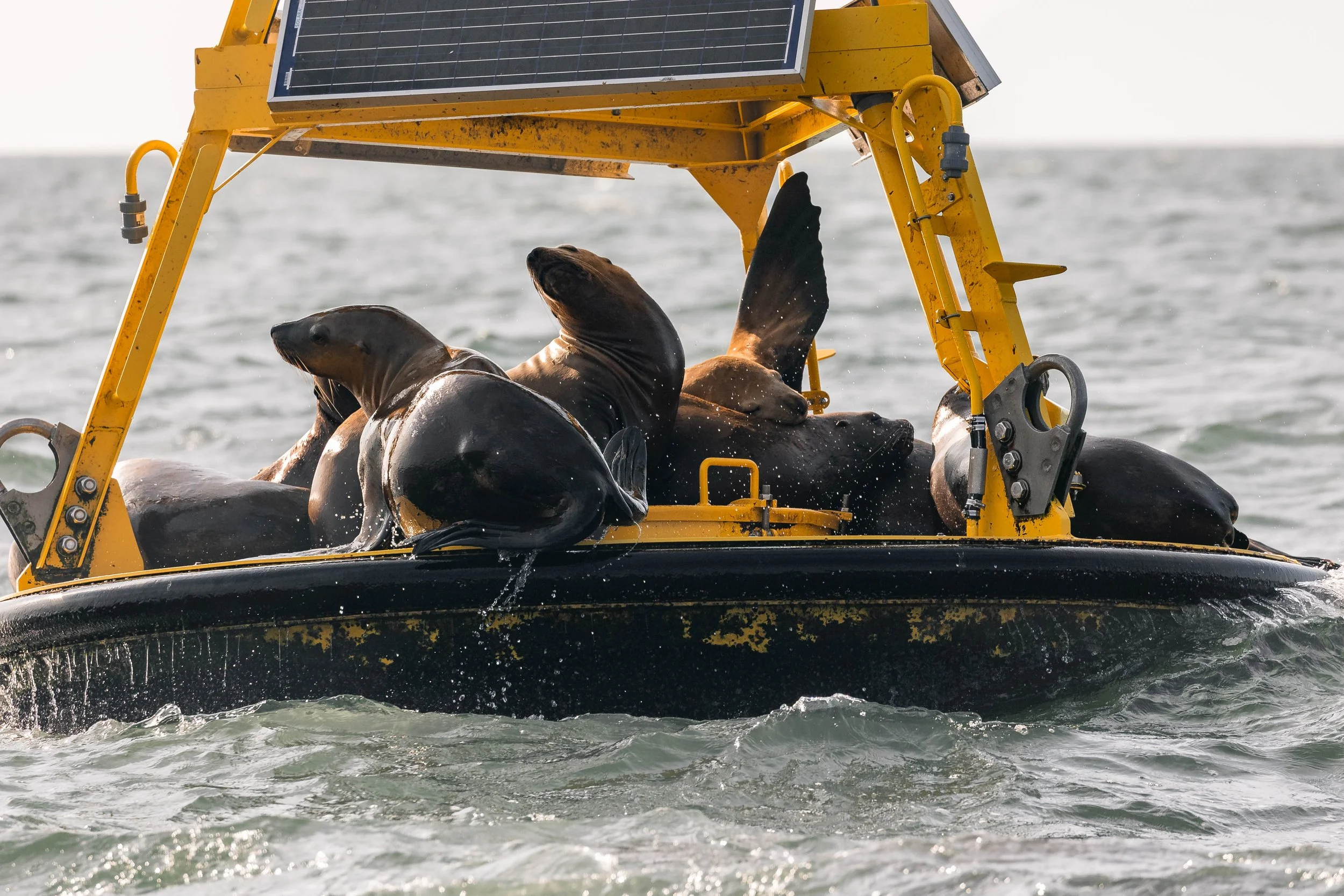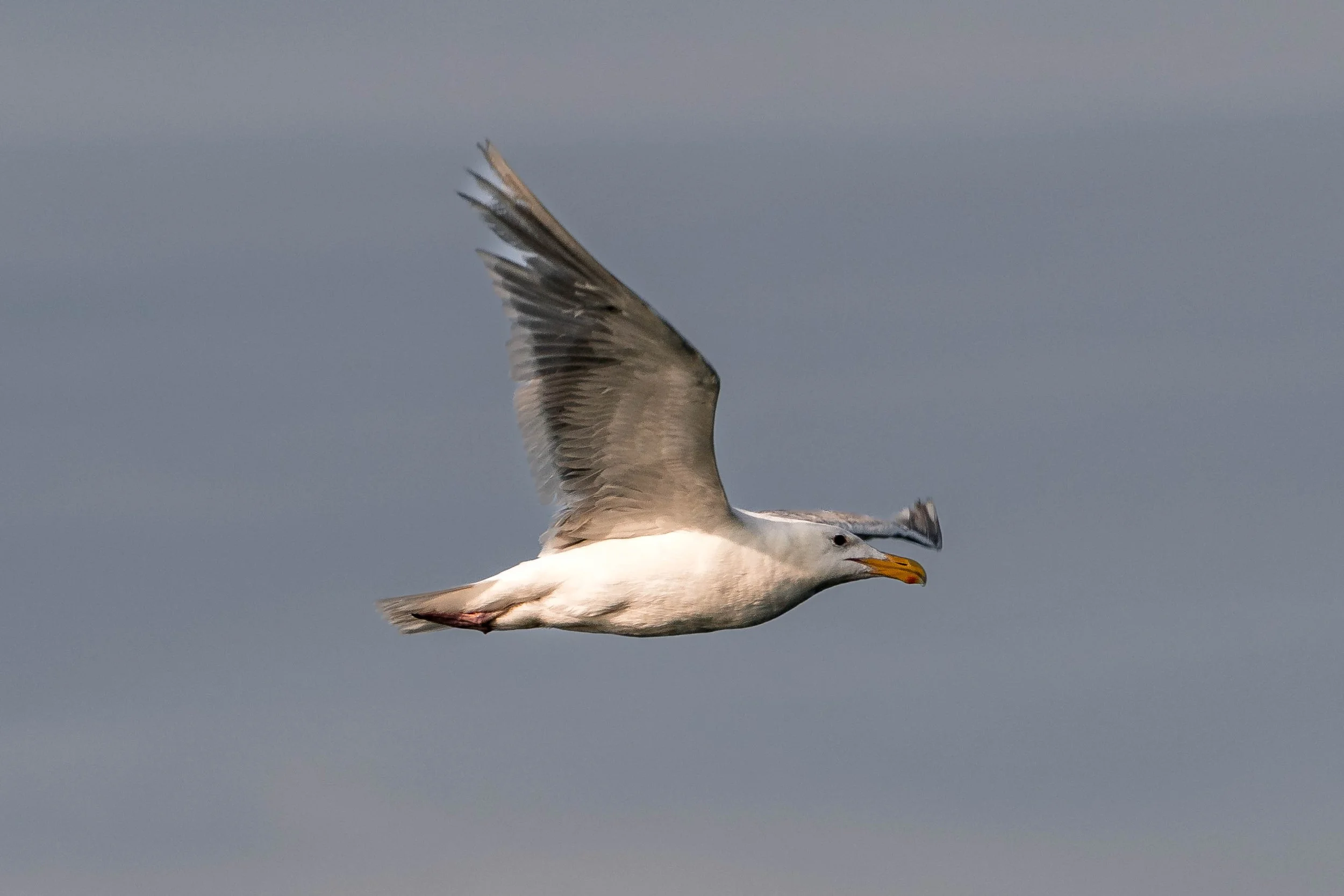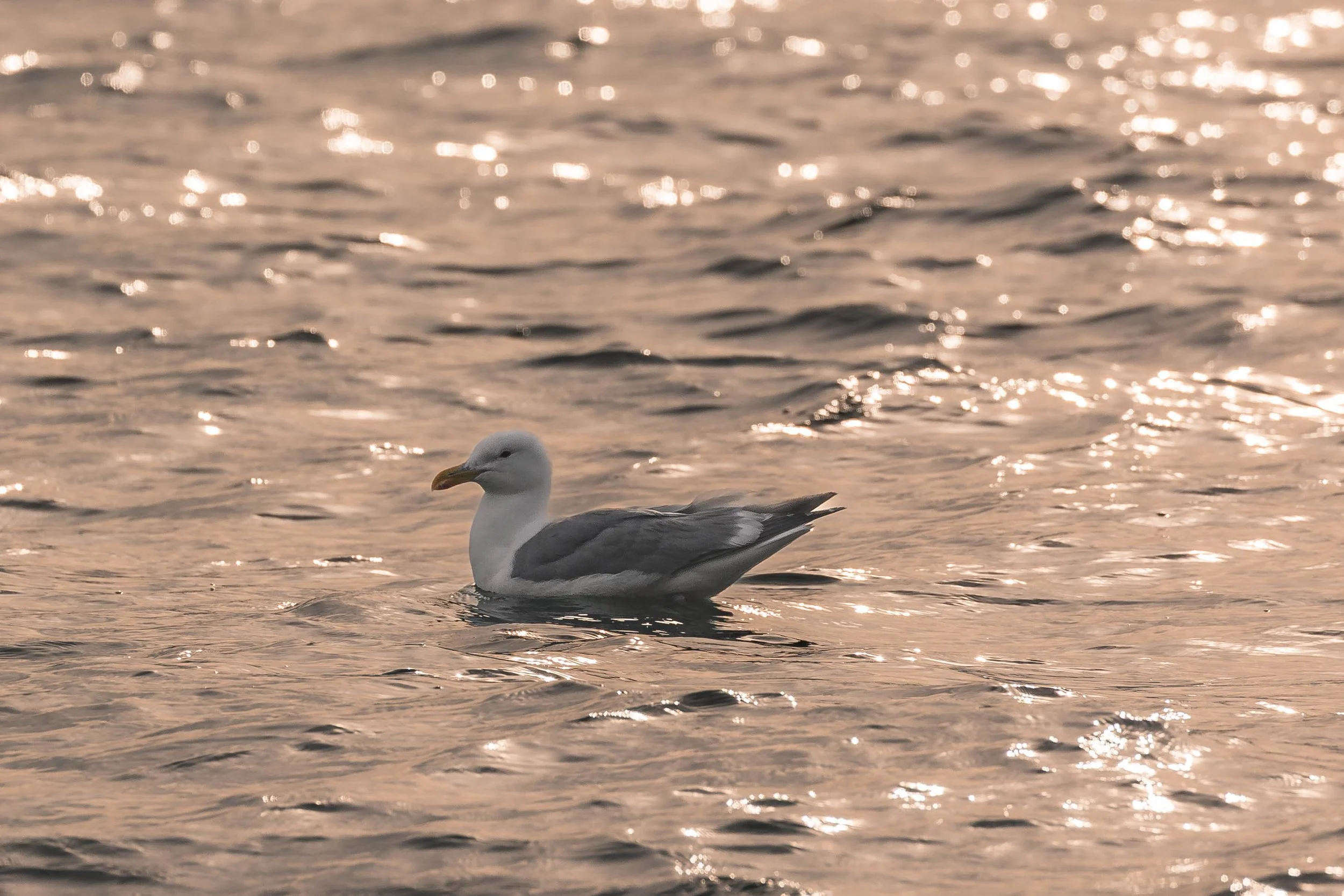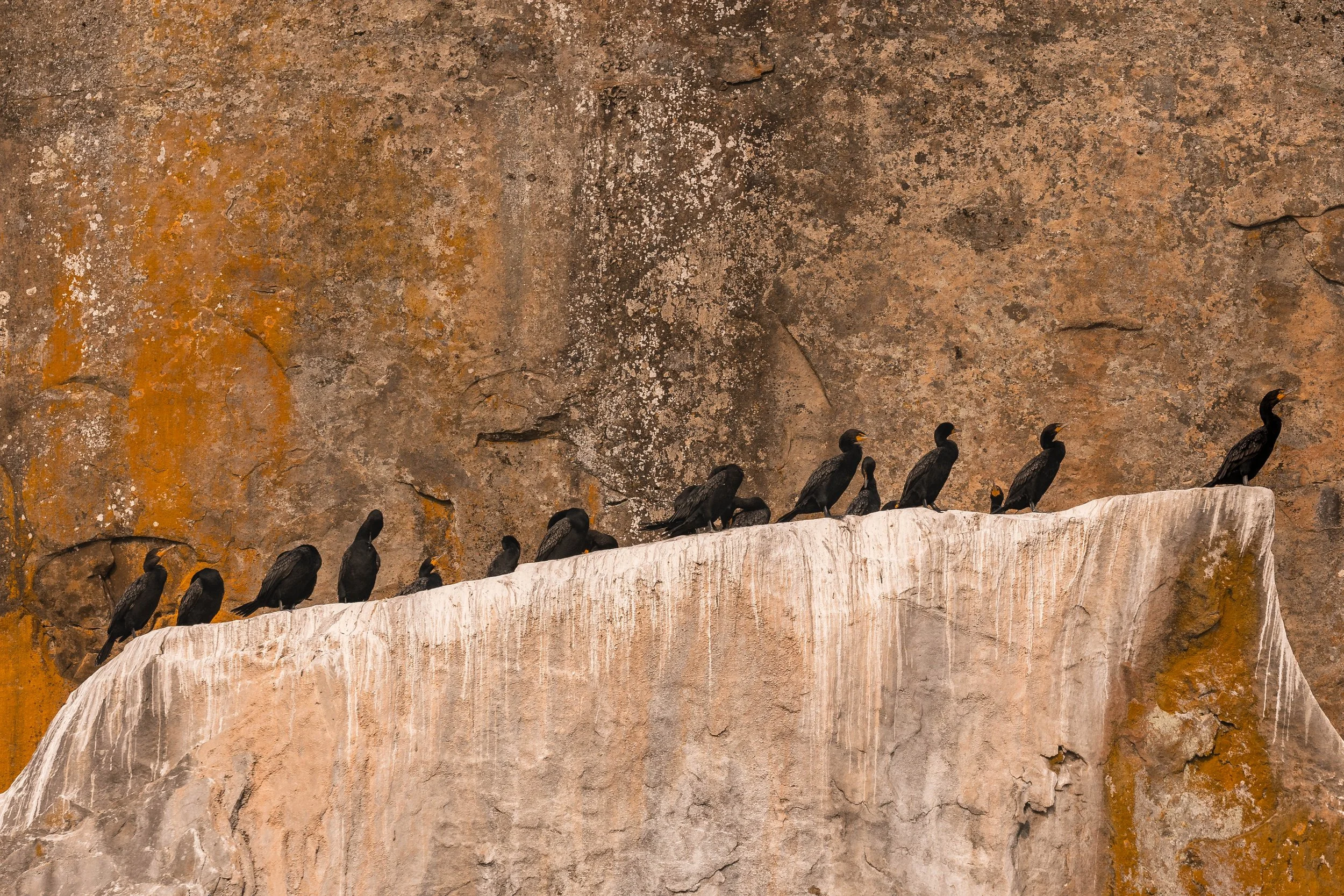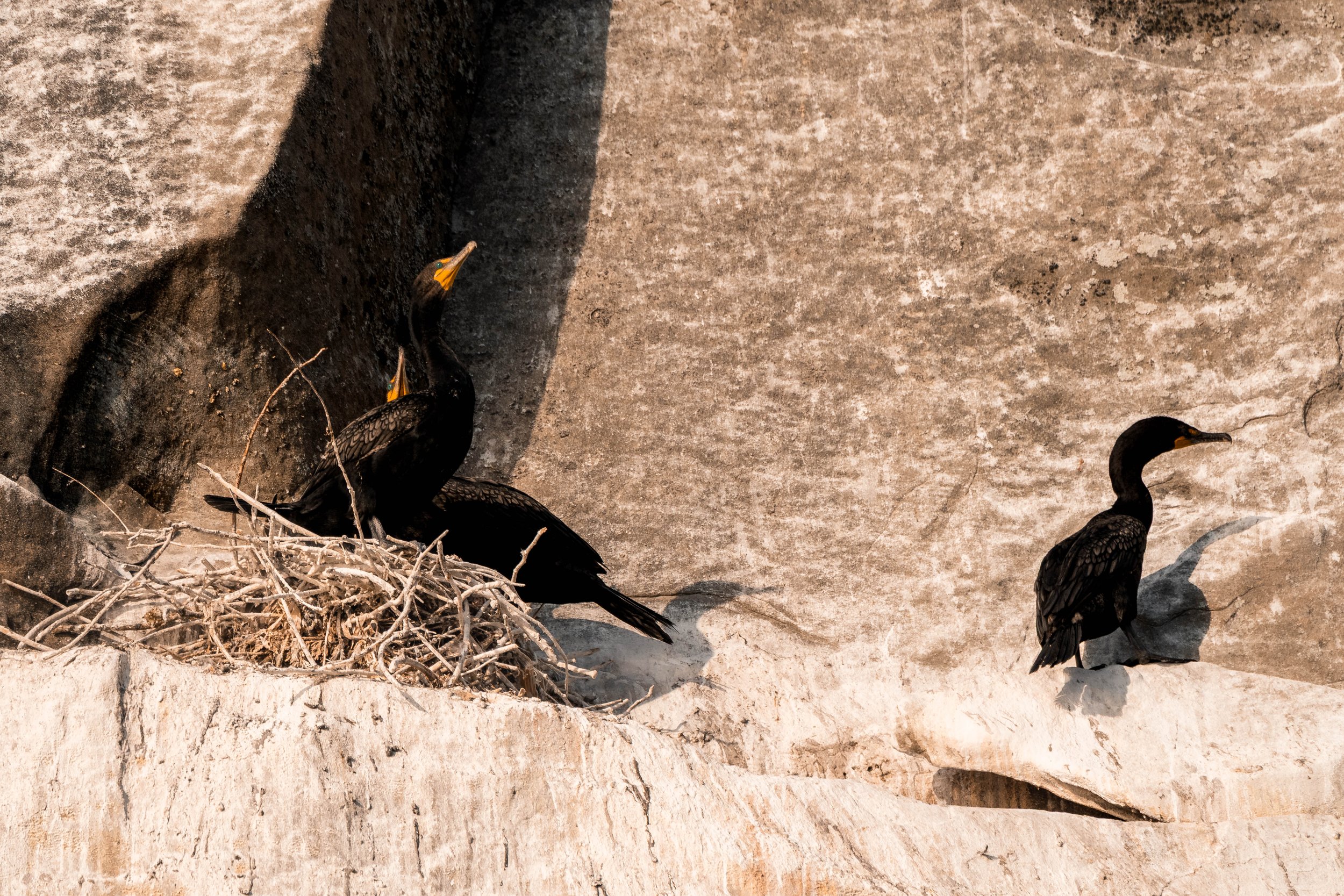August 4, 2025, 3:30 PM - Adventures in the Nursery, and orca by Halibut Bank!
The seas around Gabriola’s northern shoreline have been bustling with whale activity for the last few weeks, leading to many amazing encounters. Because of this, we have been starting many of our tours heading there, eyes peeled, searching for blows, flukes, and dorsals.
It didn’t take us long to find a modge podge of humpbacks, with many pairs passing back and forth, all associating together, travelling, and fluking. Our Naturalists began snapping a bunch of photos of the whales, working on IDing them. We were able to identify a ton of individuals, including two mother and calf pairs! The individuals identified included Ghost (BCX1333) and Ghost’s 2025 calf (BCX1333 calf 2025), Vanta (BCX1730) and Seabird (BCX1774), Graze (BCY0523) and Graze’s 2025 calf (BCY0523 calf 2025), and Smoke/Squirrel (BCX2183)! These whales kept switching who they were travelling beside, and they began spreading out a bit, leading to separate encounters between our different boats. Kula ended up spotting Smoke making their way over to where they were watching, and they also spotted Kappa (BCX0158) and Kappa’s 2025 calf (BCX0158 calf 2025) as well, leading to three separate mother-calf pairs being spotted in this small area! Because of this high concentration of mother-calf pairs being spotted in the area, this place has been lovingly dubbed the Gabriola Nursery!
It’s amazing to see so many of these gentle giants all travelling, fluking, and feeding in such close proximity. A mere 50 years ago, it was nearly impossible to see humpbacks in our area. During the whaling era, our humpbacks were heavily targeted, leading to a huge decline in their population. It wasn’t until the late 1990s that they began to show back up, with a significant population increase occurring since then, in an event we have nicknamed “The Humpback Comeback”! Now, hundreds of individuals return to the Salish Sea every year to feast in our rich food-filled waters, bringing calves and new friends around every season!
All of the whales today were acting very typical - busily travelling along and fluking, diving down and likely feeding on krill in the depths below. Now in August, the weather will soon be cooler, the leaves will turn, and the humpbacks will begin their migration south to their breeding grounds. In the meantime, they are busy packing on as many pounds as they can while in our waters, as they will not have the opportunity to feast again until they return here next spring. When you have to eat a year's worth of food in a quarter of the year, every moment counts, leading to humpbacks spending a considerable amount of their days in our waters simply eating and sleeping!
Once our time with our humpbacks was wrapping up, we headed out and began searching for our second kind of commonly seen whales - orca! With sightings earlier in the morning, we were eager to try our luck and find some ourselves this afternoon. After crossing the Strait, we began looking around Halibut Bank, and here is where we located five orca travelling together! After gathering photos of their dorsal fins, these five were identified as the T065As:
T065A Artemis ♀ (1986)
T065A2 Ooxjaa ♂ (2004)
T065A3 Amir ♂ (2007)
T065A4 Ellifrit ♀ (2011)
T065A6 Callisto ♀ (2018)
The T065As have a very odd and colourful history. Back in 2016, they were documented performing a very bizarre behaviour - they were seen live stranding on beaches, likely in an attempt to scare seals into the water. This behaviour had never been documented in the Transient orca population before, making it the first reported case in the ecotype. It’s unclear why Artemis would decide to take such a risky chance at feeding her children, but it seems it paid off, as her family is still healthy and strong to this day!
During our encounter, the T065As were busy travelling northwest while we observed them. These speedy little whales can travel over 160 kilometres in a single day, an astonishing feat, especially when you consider how much food they need to eat to keep up their weight as well! At this point, the two brothers Ooxjaa and Amir have both ‘sprouted’, or have entered puberty, leading them to have distinctly taller dorsal fins than their mother and siblings. Orca males tend to be huge ‘mama’s boys’, meaning these two chunky boys will likely spend the rest of their lives by their mother Artemis’ side.
Interestingly, their youngest brother, T065A5 Indy ♂ (2014), breaks this stereotype, as he has been travelling solo (or occasionally pod hopping) for several years now. While we will likely never know why he decided to leave his natal pod, we hope he continues to flourish and do well!
While we thought this would be the end of our whale adventures for the day, Cascadia had one more encounter in store! They found Graphite (BCX2077) travelling along, fluking and diving just like the earlier humpbacks as well! After grabbing photos for ID purposes, they continued onward.
Although our time with the whales had officially properly come to an end, that wasn’t the end of our wildlife encounters for the day! The fleet spread out, heading over to a couple of the popular haulout spots for our pinnipeds. The first haulout spot, the Halibut Bank ODAS buoy, was conveniently very close by to where we left our orca. This buoy is a nice and sturdy platform for the sea lions to sleep the day away on, and best of all, it remains at the surface of the water no matter what level the tides are at! Here, our Steller Sea Lions were snoozing and grumbling at each other as they fought for the best spots to rest. At one point, one of the sea lions tried to jump up and join the cuddle puddle, much to the disgruntlement of the rest of the group. After departing the sea lions, it was time for the final stop of the day at the Gabriola Bluffs. Here, the Cormorants were seen nestling into the cliffside, preparing to roost for the night. After taking a peek at the birds, we headed back into Nanaimo, wrapping up an incredible evening on the water!
Please enjoy these photos taken by Marine Naturalists Val Watson, Desarae Poier, and Aly Kohlman!
Ghost and her calf. Photo by Val Watson.
The tip of Ghost’s calf’s fluke with Ghost arching her back beside the calf. Photo by Val Watson.
Ghost’s fluke. Photo by Val Watson.
Vanta’s fluke. Photo by Val Watson.
Vanta’s dorsal fin. Photo by Val Watson.
Graze with her calf rolling behind her. Photo by Val Watson.
Graze’s calf’s fluke… or at least half of it! Photo by Val Watson.
Smoke’s fluke. Photo by Des Poier.
Kappa’s calf and their little ‘barnacle necklace’. Photo by Des Poier.
Kappa with her calf ahead of her. Photo by Des Poier.
Kappa defecating as she dives - her calf beside her begins to arch for a dive. Photo by Des Poier.
Fluking together. Photo by Des Poier.
Kappa’s fluke with her calf beside her. Photo by Des Poier.
Ghost’s calf’s dorsal fin. Photo by Aly Kohlman.
Ghost’s dorsal fin. Photo by Aly Kohlman.
Seabird’s fluke. Photo by Aly Kohlman.
Vanta’s dorsal fin. Photo by Aly Kohlman.
Vanta diving. Photo by Aly Kohlman.
Photo by Aly Kohlman.
Graphite’s dorsal fin. Photo by Val Watson.
Graphite’s fluke. Photo by Val Watson.
T065A4 Ellifrit and T065A Artemis (right). Photo by Val Watson.
T065A4 Ellifrit. Photo by Val Watson.
T065A3 Amir. Photo by Aly Kohlman.
T065A2 Ooxjaa. Photo by Aly Kohlman.
T065A Artemis (back) and her daughter T065A4 Ellifrit (front). Photo by Aly Kohlman.
T065A Artemis and T065A4 Ellifrit. Photo by Aly Kohlman.
T065A4 Ellfirit and T065A Artemis. Photo by Aly Kohlman.
T065A4 Ellifrit and T065A6 Callisto. Photo by Aly Kohlman.
T065A6 Callisto. Photo by Aly Kohlman.
T065A4 Ellifrit. Photo by Aly Kohlman.
Watching us as we float by. Photo by Val Watson.
Steller Sea Lions are naturally very curious! Photo by Des Poier.
Lounging around on the ODAS buoy. Photo by Des Poier.
Fighting for the best spots. Photo by Des Poier.
Yoga with the sea lions. Photo by Des Poier.
Using eachother as a pillow! Photo by Aly Kohlman.
A gull soaring by. Photo by Val Watson.
A Gull floating by. Photo by Aly Kohlman.
A gulp of Cormorants nestled on the edge of the cliff. Photo by Des Poier.
Nestled up in the Bluffs. Photo by Val Watson.


